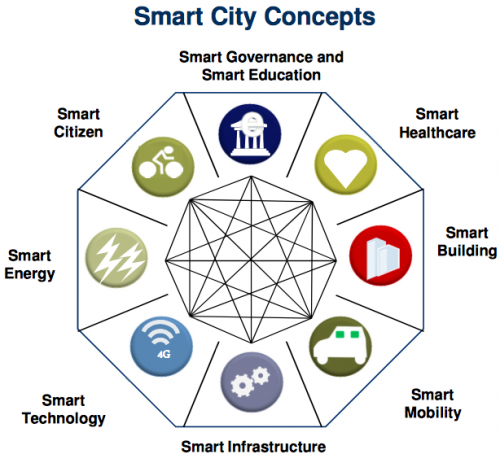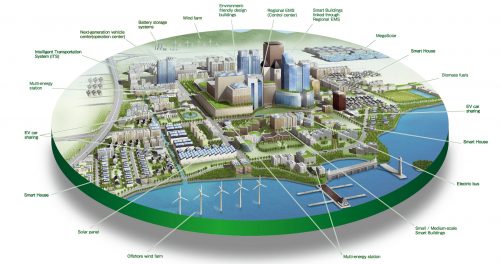
In the next decade, Smart Cities are likely to have a transformative impact on the way that we live, work, and play. With a projected cumulative global spend of $1.5 trillion on Smart City technologies by 2020 (Frost & Sullivan), implications will be felt across geographies and industries. Central to any city is its real estate; the commercial real estate industry will play a key role in the realization of society’s Smart City aspirations in a way that may revolutionize the CRE value chain.
There are a range of interpretations as to what qualifies a city as “smart”. While the term may one day be used to describe tomorrow’s urban utopias with autonomous vehicles, drone delivery, and robotic construction, today’s Smart Cities – cities like Barcelona and Singapore – are those that have a base level of connectivity and integrated municipal services. Frost & Sullivan defines smart cities as “cities built on ‘Smart’ and ‘Intelligent’ solutions and technology that will lead to the adoption of at least 5 of the 8 following smart parameters—smart energy, smart building, smart mobility, smart healthcare, smart infrastructure, smart technology, smart governance and smart education, smart citizen.” Though each of the 8 parameters bear significant real estate implications, Smart Buildings will most directly impact the industry in the near term.
The Elevator – The Last Major Evolution in the Formula of a Building
To illustrate the significance that Smart Cities may have on the real estate industry, let us first look at an innovation from the past. In 1857, Elisha Graves Otis installed the world’s first modern passenger elevator in the five story Haughwout Building in Manhattan. In a five story building, the technology was more novel than necessary, but Otis had forever transformed the world of architecture and the business of real estate. Supported by the adoption of iron-framed buildings around the same time, the elevator enabled buildings to reach new heights and shifted the ideals of premium space. In the mid 1800’s, top floors were commonly utilized only by service staff due to the effort that it took to climb flights of stairs; today, it is common for New York’s buildings to command 2% premiums for each additional floor, resulting in a 30th floor unit costing nearly double that of a unit on the 2nd floor. The elevator unlocked tremendous vertical potential in built-out cities like New York, a value that most were blind to before innovation literally turned the world of real estate upside down.
Smart Buildings will Improve Efficiency and Increase Transparency
While the elevator enabled construction to rise towards the sky, connected buildings are pushing real estate into the cloud. Smart buildings have the potential to reduce energy use, trigger preventative maintenance, and decrease operating costs. Though utilizing sensor technologies to automate operations isn’t new, an environment of interconnected devices that are in constant communication could shift the type of data collected and transform how it’s used. By tracking information such as motion, light, temperature, and water flow, then automatically analyzing data, detecting inefficiencies, and responding in a non-intrusive manner, buildings could autonomously establish and maintain optimal environments. JLL has estimated that owners utilizing smart technology can expect building efficiency to improve by 15-20% in the first year (JLL), and asset managers have recognized the opportunity; sensor deployment in the CRE sector is expected to grow at a compound annual growth rate of 78.8% between 2015 and 2020 to nearly 1.3 billion (Deloitte).
 In addition to improving operations, a myriad of building and occupant data tremendously enhances the asset valuation and transaction process. Big data reduces the reliance on broker or owner claims and enables a third party to gain a much deeper level of insight into a building’s activity and space usage patterns. In-depth building and occupant data would introduce greater transparency to real estate transactions. It would allow for stakeholders to better understand an asset and identify value-add opportunities. In retail, for example, sensors can easily determine which tenants drive foot traffic and identify patron shopping patterns. When Aref Lahham, Managing Director and Founding Partner of Orion Capital Managers, L.P., came to speak to the Baker Program as part of our Distinguished Speaker Series, he shared heat maps that showed the dynamic flow of foot traffic to different areas in Orion’s retail centers as the type of use changed during the day. Orion’s data enabled Aref and his team to make optimal tenant-mix and location decisions to maximize traffic distribution and space usage. In an office setting, the Deloitte Center for Financial Services recently commissioned a study that combined data from smart electric boxes, plumbing and water usage sensors, smart thermostats, and the measurement of human “collisions per hour per square meter” to identify factors of tenants’ employee productivity (Deloitte). This information would allow landlords to isolate and maximize the drivers of value, resulting in a boost in NOI (on both the revenue and expense sides) and an improved asset value.
In addition to improving operations, a myriad of building and occupant data tremendously enhances the asset valuation and transaction process. Big data reduces the reliance on broker or owner claims and enables a third party to gain a much deeper level of insight into a building’s activity and space usage patterns. In-depth building and occupant data would introduce greater transparency to real estate transactions. It would allow for stakeholders to better understand an asset and identify value-add opportunities. In retail, for example, sensors can easily determine which tenants drive foot traffic and identify patron shopping patterns. When Aref Lahham, Managing Director and Founding Partner of Orion Capital Managers, L.P., came to speak to the Baker Program as part of our Distinguished Speaker Series, he shared heat maps that showed the dynamic flow of foot traffic to different areas in Orion’s retail centers as the type of use changed during the day. Orion’s data enabled Aref and his team to make optimal tenant-mix and location decisions to maximize traffic distribution and space usage. In an office setting, the Deloitte Center for Financial Services recently commissioned a study that combined data from smart electric boxes, plumbing and water usage sensors, smart thermostats, and the measurement of human “collisions per hour per square meter” to identify factors of tenants’ employee productivity (Deloitte). This information would allow landlords to isolate and maximize the drivers of value, resulting in a boost in NOI (on both the revenue and expense sides) and an improved asset value.
Impact of an Interconnected Environment
The factors that can be measured and the type of data that can be collected is constantly evolving. Smart buildings will soon become commonplace; assets will operate more efficiently, and transactions will be enacted with greater transparency. The degree to which these efficiencies will be magnified with interconnected buildings, infrastructure, services, and citizens – truly Smart Cities – is yet unknown. Smart Cities may reshape city planning and zoning, and dramatically alter citizen interactions. They might even drive a shift away from the wasteful nature of today’s modern city – where we utilize different neighbourhoods during different times of the day, and waste time and energy travelling between the two.
We can only speculate as to the level of transformation that will be driven by the convergence and connectivity of buildings, infrastructure, services and citizens. For example, your vehicle might soon be able to inform your home that you’re on your way after work. With this information, the building could adjust the temperature to your preference in anticipation of your arrival. Once the lobby senses your presence (by detecting your mobile device), it might call the elevator to the main floor and set it to stop on your floor of residence. The result: you arrive at your home just the way you left it, with minimal barriers and marginal waste. Perhaps tomorrow’s buildings will even play a role in solving the arduous “last mile problem.” With e-commerce sales continuing to increase at an exponential rate, smart residential buildings may be the missing link between the delivery driver (or drone?) and the consumer. With an established process to accept packages and store them correctly – potentially opening the possibility of selling perishable goods online – a building connected to the delivery schedules of major couriers could resolve two key challenges with online shopping: the uncertainty of packages that are left in the mail-room and the trips to a distribution centre after failed delivery attempts.
Smart Cities and connected buildings will unleash a wealth of potential in the decades to come. Though technological hurdles remain, Smart Cities face the challenge of implementing and integrating technology that already exists. Just as the value of going vertical wasn’t recognized until the elevator was introduced as a novelty in the 1850’s, the value of going digital is still largely abstract. The real estate industry can merely envisage the transformational impact that will be driven by a future of interconnected buildings, infrastructure, and citizens.



